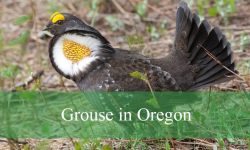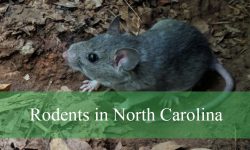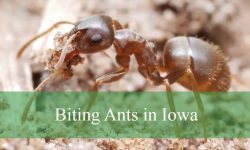Colorado is home to a wide variety of bird species, and among them, red-headed birds stand out with their vivid colors and striking beauty. From tiny finches to large woodpeckers, these birds add a splash of brightness to the state’s diverse landscapes.
Many of these red-headed species can be found in backyards, forests, and mountain trails, making them favorites among birdwatchers. Their unique behaviors, calls, and habitats make identifying them an exciting challenge.
In this guide, we’ll explore 17 birds with red heads in Colorado, complete with identification tips and habitat information to help you recognize them in the wild.
Common Birds With Red Heads Found in Colorado
House Finch
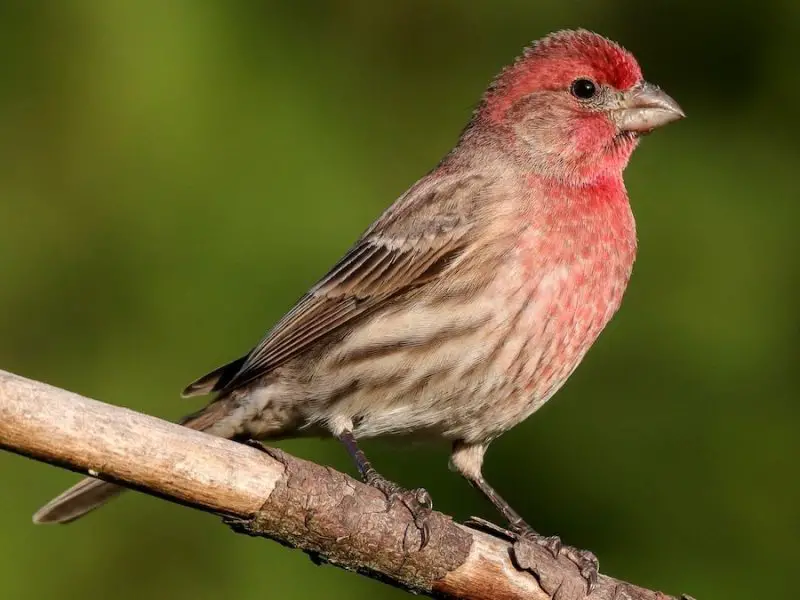
The House Finch is one of the most common red-headed birds found across Colorado, particularly in urban and suburban areas. Males are easily identified by their bright red foreheads, throats, and chests, which contrast with their streaked brown backs and wings. Females lack the red coloring and instead display plain brown streaking, making them less noticeable but well-camouflaged. These birds typically measure about 5 to 6 inches in length, with a wingspan of 8 to 10 inches.
They are known for their cheerful, warbling songs that echo through backyards and neighborhoods, especially during spring. House Finches are social birds, often gathering in flocks around feeders and in trees where food is abundant. Their diet consists mostly of seeds, grains, and fruits, and they are frequent visitors at backyard feeders stocked with sunflower seeds.
In Colorado, House Finches thrive in cities, small towns, and agricultural areas, but they also extend into open woodlands and desert habitats. They are adaptable birds and have expanded their range dramatically since being introduced to the eastern United States in the 1940s. This adaptability explains their widespread success across diverse landscapes.
A fun fact about House Finches is that the intensity of the male’s red coloring comes from the pigments in the foods he eats. The brighter the red, the more attractive he appears to females during the breeding season. This makes their plumage a direct reflection of diet and health.
Cassin’s Finch

Cassin’s Finch is another red-headed bird that can be spotted in Colorado, particularly in the mountainous regions. Males have a raspberry-red crown and throat, with streaky brown bodies that blend into the forest environment. Females and immature birds are heavily streaked brown and white, lacking any red coloration, which makes them easy to confuse with House Finches unless carefully observed. They average around 6 inches in length with a wingspan of 10 to 11 inches.
These birds are primarily seed eaters, relying on conifer seeds as well as berries and insects when available. Cassin’s Finches are known for their melodious, rich songs that often include mimicked notes from other bird species. They tend to form small flocks, especially in winter, when they forage together in high-elevation forests.
In Colorado, Cassin’s Finch populations are concentrated in the Rocky Mountains, especially in coniferous forests of pine, spruce, and fir. They are more common in the western part of the state and are less likely to be found in lowland cities and towns compared to House Finches. Their seasonal movements often bring them to lower elevations during harsh winters.
A fascinating fact about Cassin’s Finch is that males sing not only to attract mates but also to defend their feeding territories. Their songs can be surprisingly complex, lasting for minutes at a time, and are considered among the most elaborate in the finch family.
Purple Finch

The Purple Finch, although less common in Colorado than other red-headed finches, can occasionally be found in forested areas and during migration. Male Purple Finches are often described as looking like they have been dipped in raspberry juice, with reddish hues extending from their heads down through their chests and backs. Females, on the other hand, are streaked brown with a distinct whitish eyebrow stripe. These birds measure around 6 inches long, with a wingspan of 9 to 10 inches.
Their diet primarily consists of seeds, buds, and berries, though they also consume insects during the breeding season. They forage in trees and shrubs and will occasionally visit backyard feeders when natural food sources are scarce. Purple Finches are often confused with House Finches, but their more extensive red plumage and slightly larger body size help distinguish them.
In Colorado, Purple Finches are not permanent residents but are instead irregular visitors, especially in the northern and mountainous regions. They are more common in the northeastern United States but wander westward at times, particularly during irruption years when food supplies run low in their normal range. Birdwatchers in Colorado consider spotting one a treat.
An interesting fact is that the Purple Finch was once nicknamed the “sparrow dipped in raspberry juice” by famous naturalist Roger Tory Peterson, reflecting its rich and unique coloration compared to other red-headed finches.
Red Crossbill
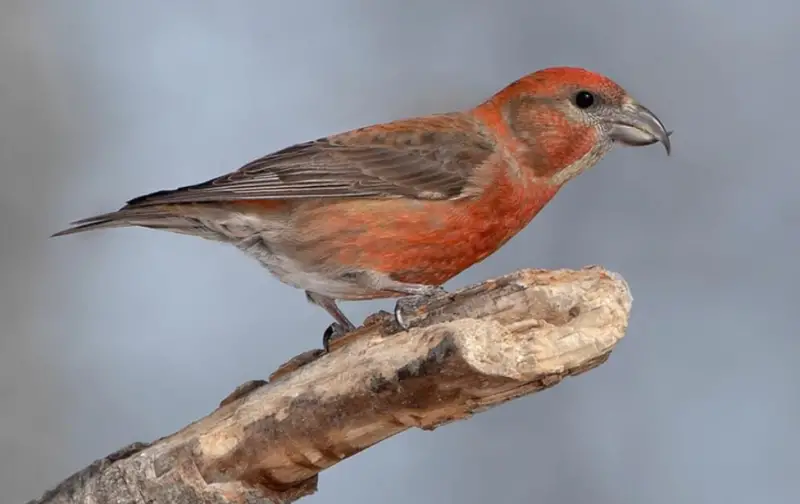
The Red Crossbill is one of the most unique red-headed birds in Colorado, easily recognized by its specialized bill. Males display reddish to orange plumage with darker wings, while females are yellowish or olive-colored. The distinctive feature of this species is its crisscrossed bill tips, perfectly adapted for prying seeds from tightly closed conifer cones. Adults typically measure 6 to 8 inches in length, with wingspans of 10 to 11 inches.
Behaviorally, Red Crossbills are nomadic, moving in flocks wherever cone crops are abundant. Their diet is almost entirely composed of conifer seeds, and their flocks can sometimes be seen hanging upside down from branches as they extract food. Their loud “jip-jip” flight calls are often heard before the birds are seen.
In Colorado, Red Crossbills are found primarily in coniferous forests across the Rocky Mountains. They are year-round residents in these habitats, although their numbers and movements vary depending on cone availability. Birders often find them in spruce and pine forests at higher elevations.
A fun fact about Red Crossbills is that different populations have slightly different bill sizes, specialized for different types of conifer cones. This has led scientists to consider whether Red Crossbills might eventually split into multiple distinct species.
Pine Grosbeak
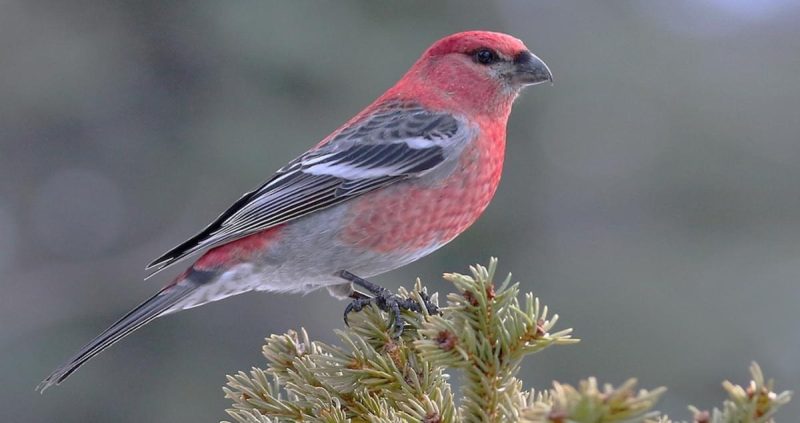
The Pine Grosbeak is one of the larger red-headed birds in Colorado, with males showing a soft rosy-red coloration on the head, chest, and back. Females and young males are a more subdued gray with yellow or orange highlights on the head and rump. These birds are chunky, measuring about 8 to 10 inches long with wingspans up to 14 inches, making them one of the largest finches in the state.
They are generally calm and slow-moving birds, often seen foraging in trees for buds, seeds, and berries. Unlike other finches, Pine Grosbeaks are not very aggressive at feeders, often allowing smaller birds to eat alongside them. Their calls are soft, flute-like whistles that add a gentle musical quality to their alpine habitats.
In Colorado, Pine Grosbeaks are primarily found in the high-elevation spruce and fir forests of the Rockies. They may descend into lower valleys during winter, especially when snow cover reduces food availability. They are most frequently encountered in the western and central parts of the state.
A charming fact about Pine Grosbeaks is that they are sometimes called “gentle giants” of the finch world because of their large size paired with their docile and tame nature. They often show little fear of humans and can be approached quite closely.
Vermilion Flycatcher
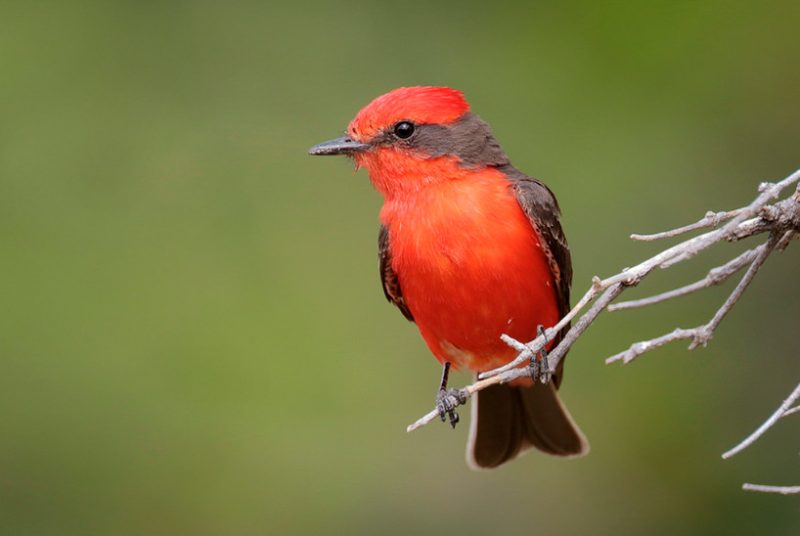
The Vermilion Flycatcher is a striking red-headed bird occasionally spotted in southern Colorado, particularly near riparian areas. Males are unmistakable with their brilliant scarlet-red plumage on the head, chest, and underparts, paired with dark brown wings and back. Females are more modestly colored, with pale underparts and a peachy wash on the belly. They are small songbirds, measuring about 5 to 6 inches long, with a wingspan of 9 to 10 inches.
These flycatchers are aerial hunters, catching insects in midair with incredible precision. They often perch conspicuously on fences, shrubs, or branches, sallying out to snatch flying prey before returning to their perch. Their feeding behavior makes them fun to watch, especially when they dart and hover in pursuit of insects.
In Colorado, Vermilion Flycatchers are rare and mostly restricted to the southeastern portion of the state. They favor open country with scattered trees and water sources, such as river valleys, farmlands, and desert edges. Sightings are more likely in spring and summer when males are displaying their vivid breeding plumage.
A fascinating fact about the Vermilion Flycatcher is that males often perform fluttering courtship flights, singing while showing off their brilliant red plumage to impress females. Their dazzling colors make them one of the most eye-catching birds in the American Southwest.
Northern Cardinal
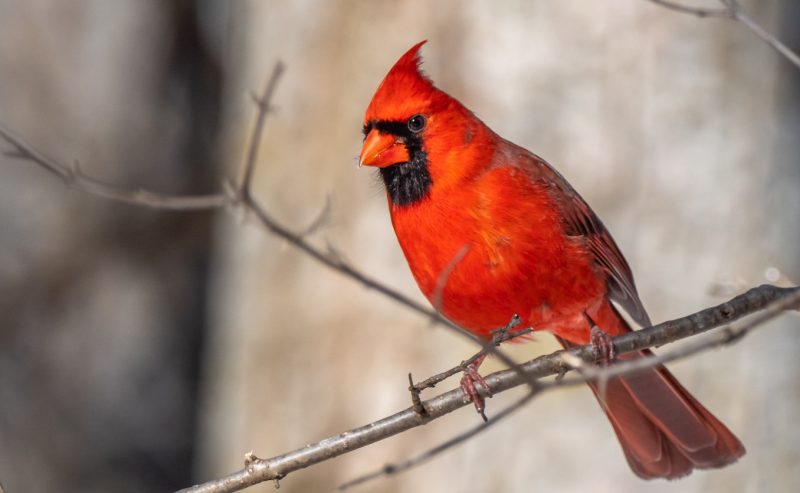
The Northern Cardinal is one of the most iconic red-headed birds, instantly recognizable by its brilliant crimson plumage and striking crest. Males are vivid red all over, with a black mask around the bill and throat, while females display warm brown tones with reddish highlights on the wings and tail. Cardinals measure about 8 to 9 inches in length, with a wingspan of 10 to 12 inches. Their strong, conical orange bills are adapted for cracking seeds.
These birds are well known for their rich, melodious whistles, often heard year-round. Males sing to defend their territories and to attract mates, while females may also sing, especially during nesting season. Northern Cardinals are non-migratory, often seen in pairs or family groups throughout the year. Their diet consists mainly of seeds, fruits, and insects, and they are frequent visitors at backyard feeders.
In Colorado, Northern Cardinals are not as widespread as in the eastern United States but can be found in the southeastern portion of the state. They inhabit woodlands, riparian areas, and suburban neighborhoods where dense shrubs and trees provide cover. Sightings are less common in the mountainous regions but occur in lowland areas where vegetation is plentiful.
A fun fact is that the Northern Cardinal is one of the few bird species in which both males and females sing. Their duets often serve as a form of communication between mates, especially during the nesting season, helping strengthen pair bonds.
Summer Tanager
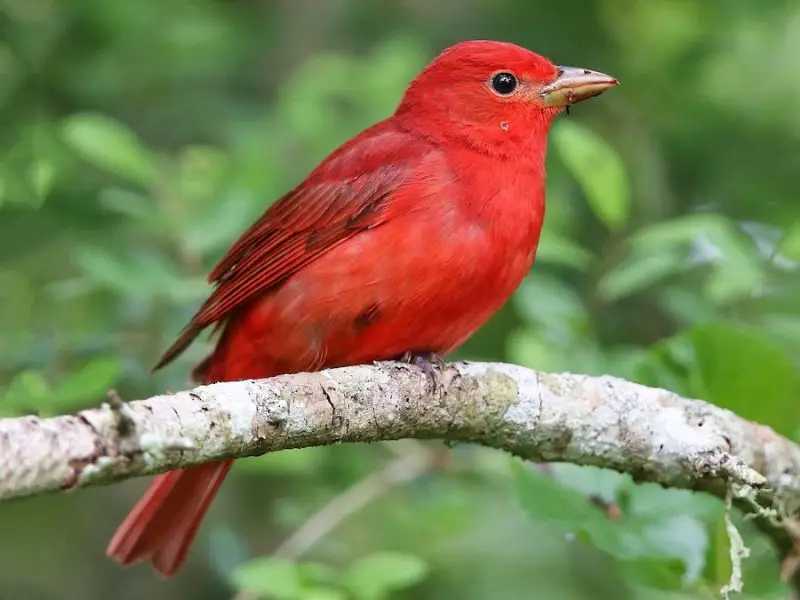
The Summer Tanager is a stunning red-headed bird, with males showing uniform scarlet plumage across the entire body. Females and immature birds, by contrast, are yellowish-green, providing excellent camouflage among foliage. Adults measure about 7 inches in length with a wingspan of 11 to 12 inches, and they have thick, slightly curved bills well-suited for catching insects.
These tanagers are famous for their preference for bees and wasps, which they skillfully catch in flight. They often beat their prey against branches to remove stingers before swallowing. Their diet also includes other insects, as well as fruits during late summer and fall. Males are known for their clear, robin-like songs, which they use to mark territories.
In Colorado, Summer Tanagers are more commonly found in the southeastern part of the state during the breeding season. They prefer open woodlands, riparian corridors, and areas with scattered tall trees, especially cottonwoods and oaks. They are less common in the Rockies but may appear in lower elevations during migration.
A fun fact about Summer Tanagers is that they are sometimes called “bee birds” because of their habit of eating large numbers of bees and wasps. This unique diet helps reduce insect populations while providing them with high-protein meals.
Western Tanager
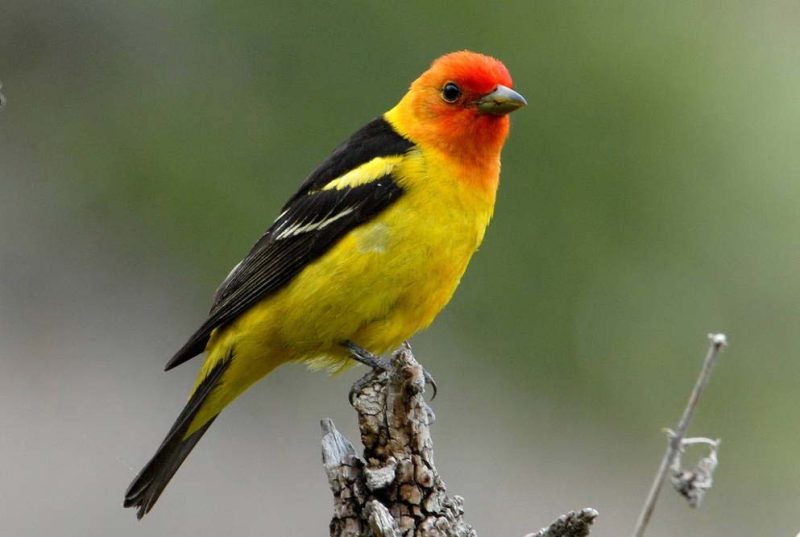
The Western Tanager is one of Colorado’s most striking red-headed birds, with males displaying bright yellow bodies, black wings with white wing bars, and fiery red-orange faces. Females are more subdued, with olive-yellow plumage and less vivid coloration on the head. These birds are medium-sized songbirds, measuring about 7 inches in length and 11 inches across the wings.
They feed primarily on insects during the breeding season, often foraging in the treetops or catching flying insects midair. Later in the year, their diet shifts toward fruits and berries. Their song is a series of short, burry notes that somewhat resemble the song of an American Robin, though less musical.
In Colorado, Western Tanagers are common summer visitors, especially in coniferous and mixed forests of the Rocky Mountains. They are often seen flitting among tall pines, firs, and aspens, bringing bright splashes of color to the mountain landscape. During migration, they may also appear in lower valleys and towns.
A fun fact is that the red coloration on a male Western Tanager’s face does not come from pigments produced by the bird itself. Instead, they acquire the pigment from their insect diet, specifically from compounds called rhodoxanthin, making their plumage partly dependent on what they eat.
Red-headed Woodpecker
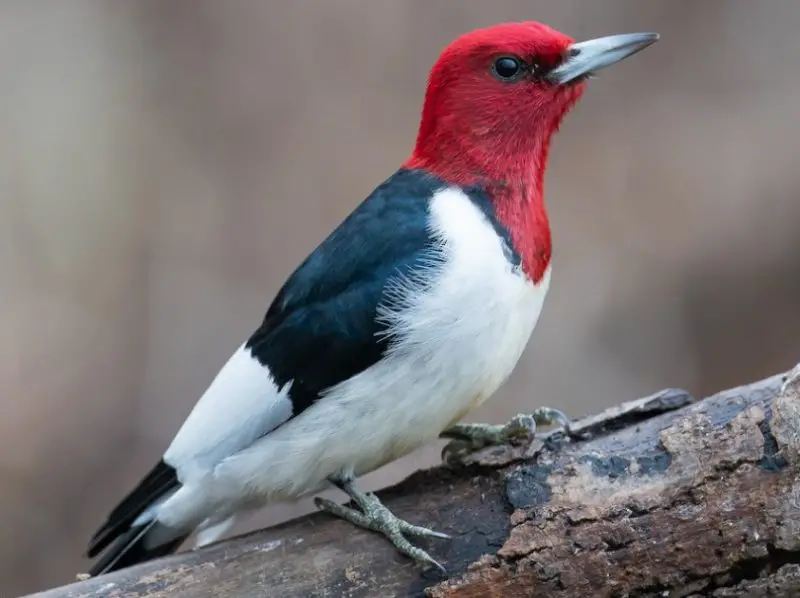
The Red-headed Woodpecker is one of the most boldly patterned birds in Colorado, known for its striking crimson head, snowy white body, and jet-black wings with large white patches. Unlike other woodpeckers, both males and females look nearly identical, measuring about 7 to 9 inches in length with a wingspan of 16 to 17 inches. Their sharp bills are perfectly designed for drilling into wood and catching insects.
These woodpeckers are versatile feeders, consuming insects, nuts, seeds, and even small animals. Unlike most woodpeckers, they are skilled at catching insects in midair, a behavior more typical of flycatchers. They are also known to store food, wedging acorns and insects into tree bark for later consumption.
In Colorado, Red-headed Woodpeckers are found mostly in the eastern plains and riparian corridors where open woodlands and scattered trees provide suitable habitat. They are less common in the mountainous regions but appear in areas with cottonwoods and oak groves. Their populations can fluctuate greatly depending on food availability.
A fascinating fact is that Red-headed Woodpeckers were once called “flying checkerboards” because of their bold, contrasting black-and-white wings that stand out in flight. Their dramatic appearance makes them easy to spot from a distance.
Pileated Woodpecker
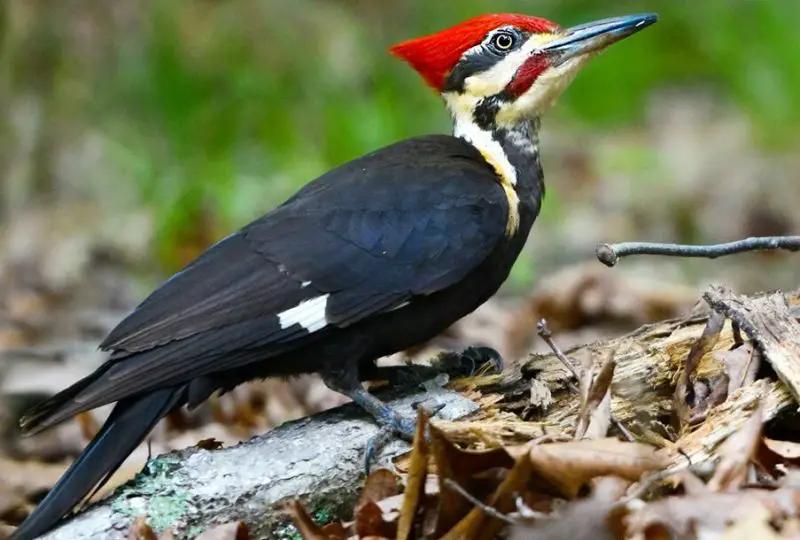
The Pileated Woodpecker is the largest woodpecker in Colorado and one of the most impressive red-headed birds in North America. Males and females both display a striking black body with bold white wing stripes and a flaming red crest. Males also have a small red stripe on the cheek, while females lack this marking. Adults measure about 16 to 19 inches in length, with a wingspan of up to 30 inches.
Their powerful bills are used to excavate deep rectangular holes in trees, searching for carpenter ants and beetle larvae. These feeding holes are so large and distinctive that they are often the first clue to the bird’s presence. Pileated Woodpeckers also drum loudly on hollow trees, producing a resonant sound that can be heard from far away.
In Colorado, Pileated Woodpeckers are mainly found in mature forests in the foothills and mountains, especially where large trees provide nesting and foraging opportunities. They require extensive woodland habitat and are less likely to appear in open country or heavily urbanized areas. Their presence is often associated with healthy, old-growth forests.
A fun fact is that the Pileated Woodpecker is thought to have inspired the famous cartoon character Woody Woodpecker, thanks to its size, red crest, and loud, maniacal calls. Their dramatic appearance and powerful drumming make them unforgettable birds to encounter in the wild.
Hairy Woodpecker
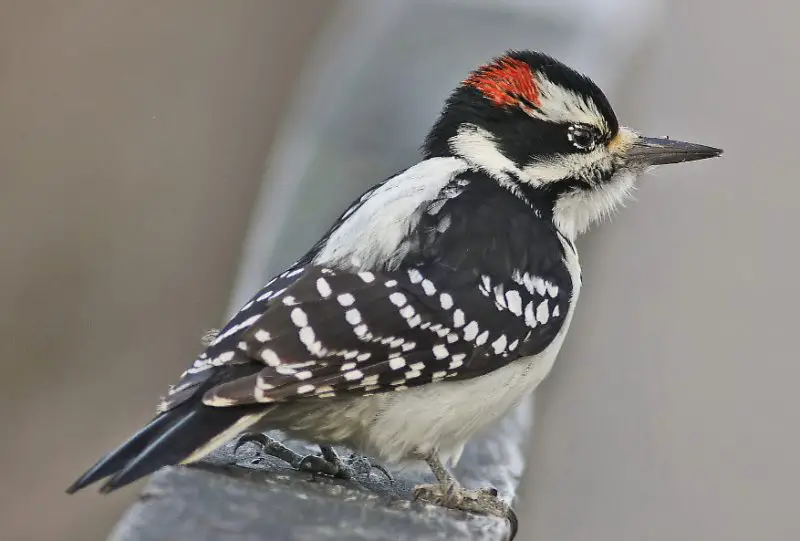
The Hairy Woodpecker is a medium-sized woodpecker commonly found across Colorado’s forests and woodlands. It has a black-and-white checkered pattern on its wings, a white underside, and a long, sturdy bill that makes it look quite strong for its size. Males have a small red patch on the back of the head, while females lack this feature. Adults typically measure about 9 inches in length, with a wingspan of 15 inches.
These woodpeckers spend much of their time clinging to tree trunks, where they hammer into bark in search of insects, particularly beetle larvae and ants. They also eat seeds and berries, especially in the winter when insects are scarce. Their sharp “peek” calls and rapid drumming sounds are often heard before the birds are seen.
In Colorado, Hairy Woodpeckers inhabit a wide range of wooded environments, from mountain conifer forests to riparian corridors and suburban parks. They are year-round residents and adapt well to both high-elevation forests and lower valleys where mature trees are present.
A fun fact about Hairy Woodpeckers is that they are often confused with Downy Woodpeckers, but one way to tell them apart is their bill length. The Hairy Woodpecker’s bill is as long as its head, while the Downy’s is much shorter, giving a key clue to proper identification.
Downy Woodpecker
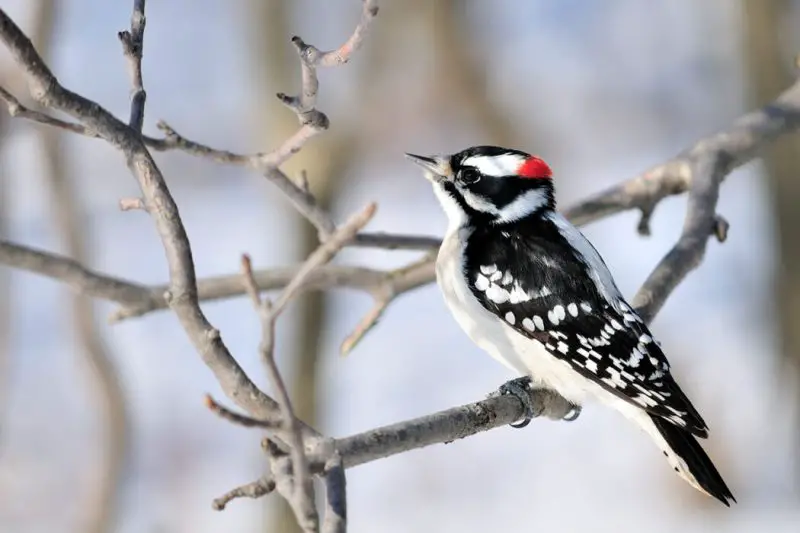
The Downy Woodpecker is the smallest woodpecker in North America and a familiar sight across Colorado. With its black-and-white plumage and small size, it closely resembles the Hairy Woodpecker, though its bill is shorter and more delicate. Males display a small red patch on the back of the head, while females do not. Adults measure about 6 to 7 inches in length, with a wingspan of 10 to 12 inches.
These woodpeckers are active and agile foragers, often seen on small branches and twigs where they hunt for insects. Their diet includes beetles, ants, caterpillars, as well as seeds and suet from bird feeders. Unlike larger woodpeckers, they frequently visit backyard feeders, making them a common sight in suburban settings.
In Colorado, Downy Woodpeckers live in a variety of habitats, including forests, orchards, riparian areas, and even urban parks. They are year-round residents throughout much of the state and adapt well to both wild and human-influenced landscapes. Their smaller size allows them to forage where larger woodpeckers cannot.
A fun fact is that despite their small size, Downy Woodpeckers are tough and resourceful birds. They often join mixed-species flocks in winter, moving alongside chickadees and nuthatches, which helps them find food more efficiently and avoid predators.
Red-naped Sapsucker
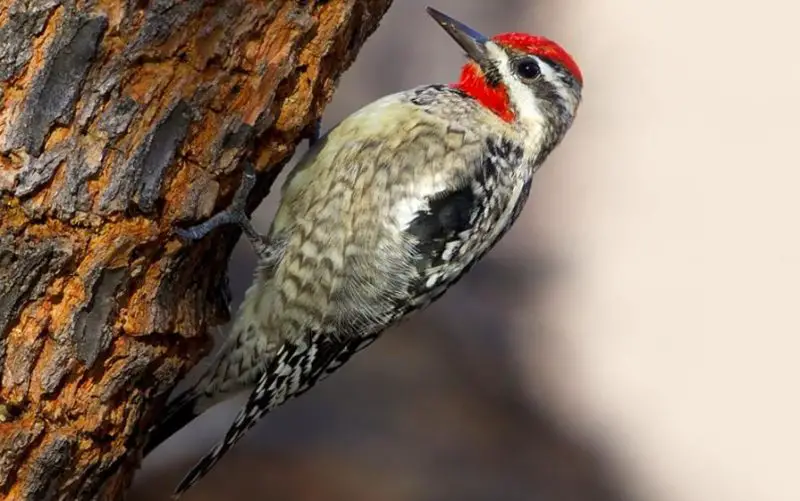
The Red-naped Sapsucker is a striking woodpecker found in Colorado, easily recognized by the red patch on its head and throat, bordered by black-and-white facial stripes. Both males and females share this pattern, though males often show brighter throat coloration. Adults measure about 7 to 8 inches long, with wingspans of 16 inches.
These birds are famous for their feeding habits, drilling neat rows of holes in tree bark to access sap. They also consume the insects attracted to the sap, making them both sappers and insect hunters. Their drumming and mewing calls are distinctive, often revealing their presence in aspen groves or mixed forests.
In Colorado, Red-naped Sapsuckers are summer residents, breeding primarily in mountain forests with aspen, cottonwood, or conifer trees. They are especially common in the central and western parts of the state, migrating southward in winter to warmer regions. Their preference for sap-rich trees makes them important contributors to the forest food chain.
A fun fact about this species is that the sap wells they create provide food not only for themselves but also for hummingbirds, warblers, and other small animals that rely on the sugary liquid and insects drawn to it. In this way, Red-naped Sapsuckers act as ecosystem helpers.
Williamson’s Sapsucker
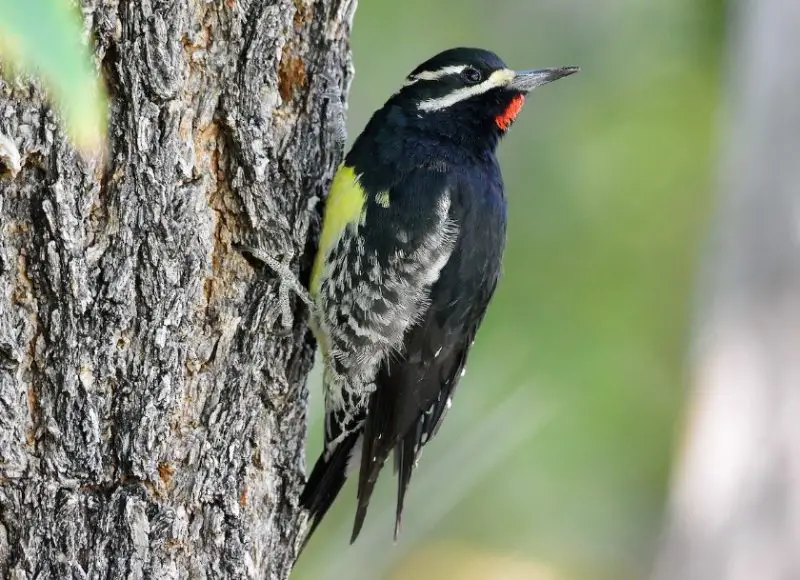
Williamson’s Sapsucker is one of the more unusual woodpeckers in Colorado, notable for its strong sexual dimorphism—males and females look strikingly different. Males have glossy black plumage with a red throat patch and a bright yellow belly, while females are mostly brown and heavily barred with black and white. Both sexes measure around 8 to 10 inches in length, with wingspans up to 17 inches.
Like other sapsuckers, they feed by drilling sap wells into trees, especially conifers. They also consume ants, beetles, and other insects, as well as berries when available. Their foraging activity often leaves visible rectangular holes in tree bark, which are reused over time to keep sap flowing.
In Colorado, Williamson’s Sapsuckers are primarily found in the mountainous regions, particularly in mixed conifer forests. They are breeding residents in summer, nesting in cavities they excavate in dead or decaying trees. During migration and winter, they move to lower elevations, sometimes appearing in foothill woodlands.
A fascinating fact about Williamson’s Sapsucker is that it is the only woodpecker in North America where the male and female look so different that they were once described as separate species. This striking difference in plumage continues to intrigue birdwatchers and ornithologists alike.
Northern Flicker (Red-shafted Flicker)
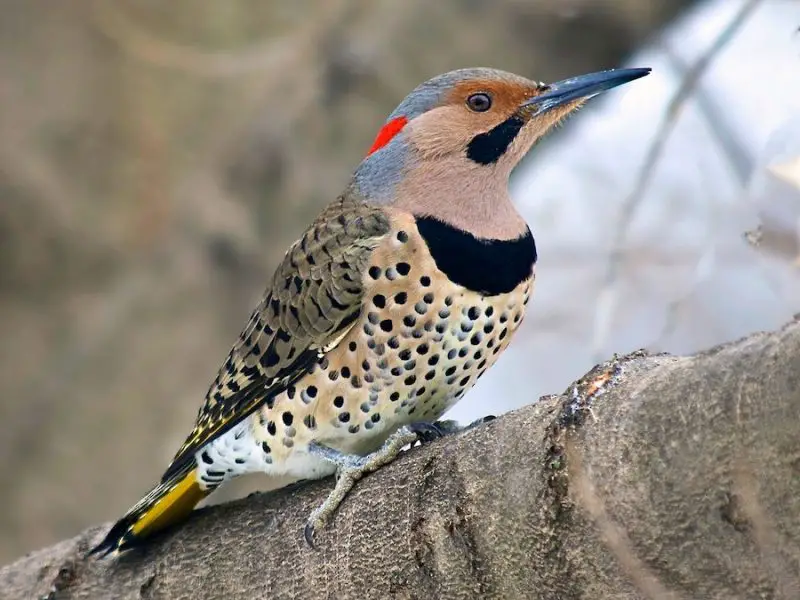
The Northern Flicker, particularly the Red-shafted Flicker subspecies, is one of the most widespread and distinctive woodpeckers in Colorado. Unlike many woodpeckers that are mostly black and white, Northern Flickers have brownish bodies with black barring, a spotted chest, and striking red shafts in their wing and tail feathers that flash brightly in flight. Males can be identified by their red mustache stripe, while females lack this feature. These birds are large, measuring 11 to 12 inches in length, with wingspans of about 20 inches.
Flickers have unique feeding habits compared to other woodpeckers. Instead of spending all their time hammering on trees, they forage on the ground, probing soil for ants and beetles, which make up the bulk of their diet. Their long, barbed tongues are perfect for extracting insects from the ground. They also consume fruits and seeds, particularly during the winter months.
In Colorado, Northern Flickers are common year-round residents and can be found in forests, open woodlands, grasslands with scattered trees, and even suburban neighborhoods. They nest in tree cavities, often excavating their own but sometimes using existing holes. Their loud, repeated “wick-a-wick-a-wick” calls and strong drumming sounds make them easy to detect.
A fun fact about Northern Flickers is that they are one of the few woodpecker species that regularly migrates. While some stay in Colorado all year, many move south for the winter, creating seasonal shifts in their populations. Their ground-foraging behavior also makes them unusual among woodpeckers.
Lewis’s Woodpecker

Lewis’s Woodpecker is a striking and somewhat unusual woodpecker species that can be found in Colorado, particularly in open pine forests and foothills. Unlike most woodpeckers, it has dark, glossy greenish-black plumage with a pinkish belly, gray collar, and a deep red face patch. This bold coloration sets it apart from other species. Adults measure about 10 to 11 inches long, with wingspans reaching 19 to 20 inches.
Behaviorally, Lewis’s Woodpecker is unique because it does not rely heavily on drumming or tree drilling for food. Instead, it often hunts insects by catching them in midair, flying more like a flycatcher than a typical woodpecker. It also eats nuts, acorns, and berries, storing them in crevices to eat later. Their graceful, slow wingbeats make them look more like crows in flight than woodpeckers.
In Colorado, Lewis’s Woodpeckers are found primarily in the western and southern portions of the state. They prefer open ponderosa pine forests, burned woodlands, and riparian areas with large cottonwoods. Their populations are somewhat irregular, fluctuating based on food availability, especially acorn and pine seed crops.
A fascinating fact about Lewis’s Woodpecker is that it was named after Meriwether Lewis of the Lewis and Clark expedition, who first documented the bird during the famous journey. Its unusual feeding behavior and vivid coloration make it one of the most distinctive woodpeckers in North America.
FAQs about Birds with Red Heads in Colorado
What birds in Colorado have red heads?
Some of the most common red-headed birds in Colorado include House Finch, Cassin’s Finch, Purple Finch, Red Crossbill, Western Tanager, Northern Flicker, and Red-headed Woodpecker. Others such as Vermilion Flycatcher, Lewis’s Woodpecker, and Summer Tanager are less common but still possible to spot.
Are all red-headed birds in Colorado woodpeckers?
No, not all red-headed birds are woodpeckers. While species like the Red-headed Woodpecker, Pileated Woodpecker, and Northern Flicker do have red on their heads, many other birds like finches, grosbeaks, and tanagers also display striking red plumage on their heads and bodies.
Where is the best place to see red-headed birds in Colorado?
The best places to see red-headed birds in Colorado vary by species. Mountain forests are excellent for spotting Red Crossbills, Pine Grosbeaks, and Western Tanagers, while riparian areas and open woodlands attract species like Northern Flickers and Summer Tanagers. Suburban backyards with feeders are reliable spots for House Finches and Downy Woodpeckers.
Do red-headed birds stay in Colorado year-round?
Some red-headed birds, such as House Finches, Hairy Woodpeckers, and Northern Flickers, are year-round residents in Colorado. Others, like Western Tanagers and Red-naped Sapsuckers, are migratory and only appear during the breeding season or migration periods.
How can I tell the difference between a House Finch and a Cassin’s Finch?
House Finches usually have red limited to the forehead and chest, with more streaking on the belly, while Cassin’s Finches show a brighter raspberry-red crown and more extensive coloration. Cassin’s Finches also tend to appear slightly larger and have longer, straighter bills than House Finches.
Do red-headed birds visit backyard feeders?
Yes, several species of red-headed birds readily visit backyard feeders in Colorado. House Finches, Downy Woodpeckers, and Hairy Woodpeckers are frequent visitors, while Pine Grosbeaks and Purple Finches may appear occasionally. Providing sunflower seeds, suet, and fruit can help attract these colorful species.


